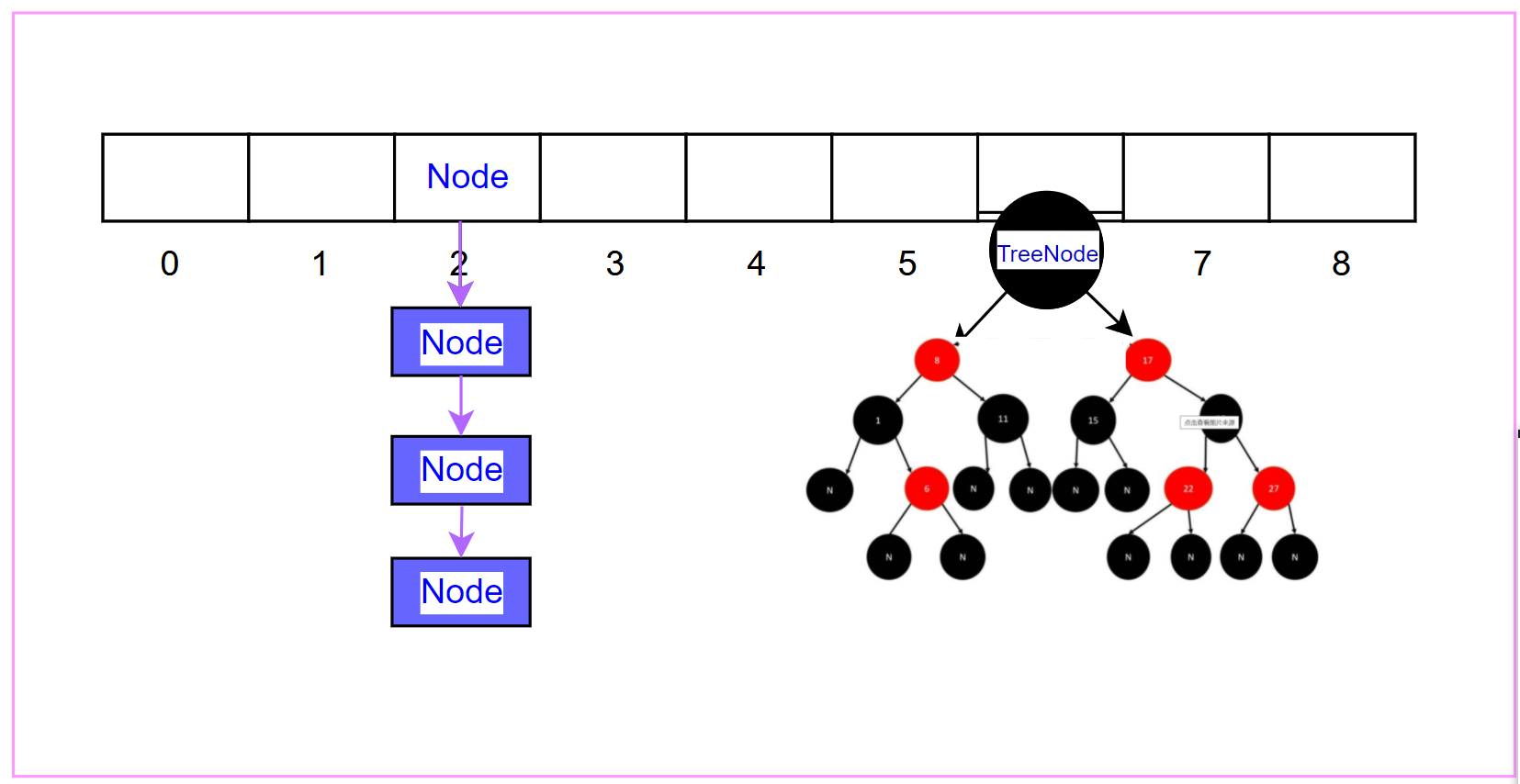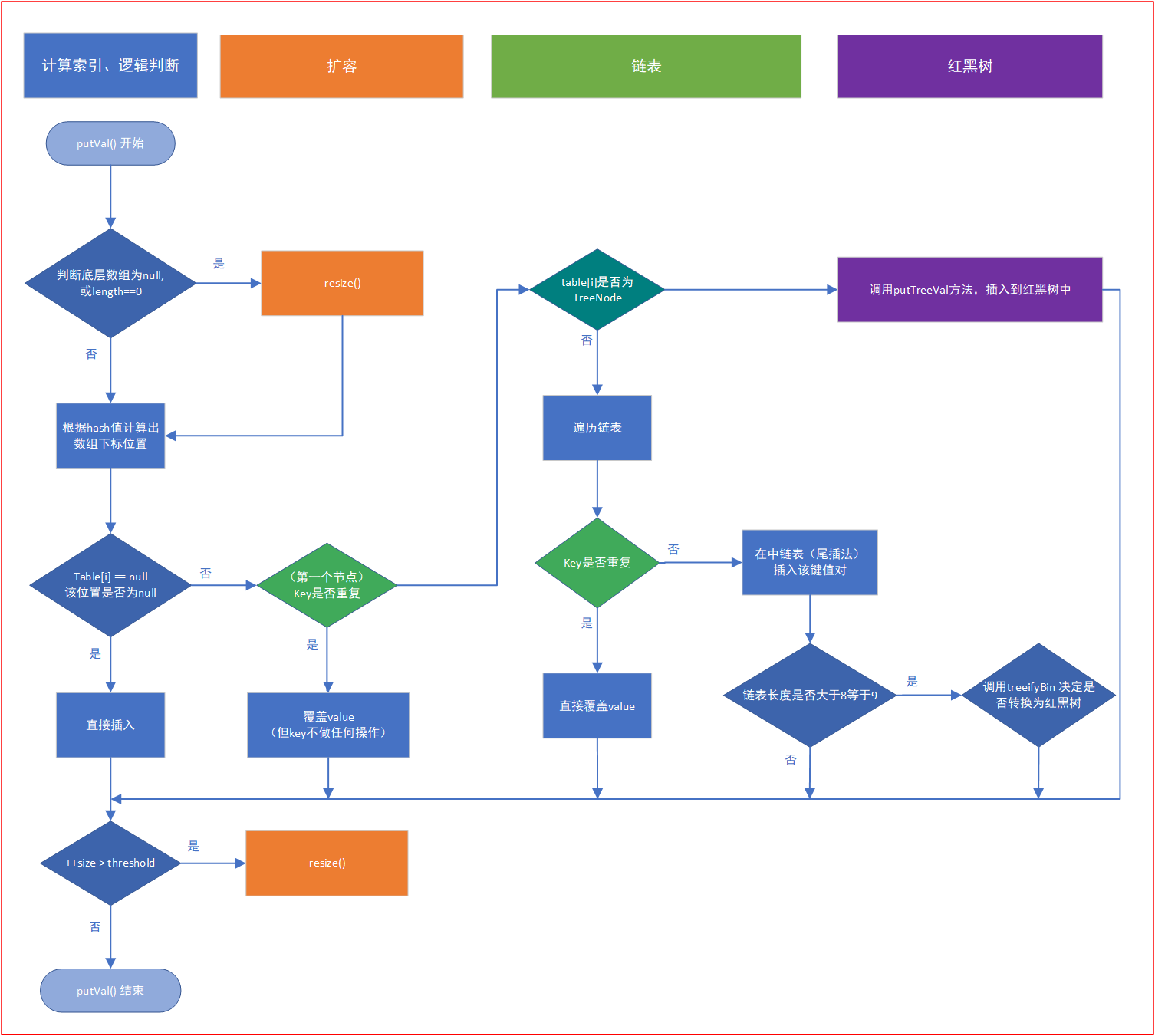1. 底层结构
==数组 + 链表 + 红黑树== (jdk1.8之前没有红黑树结构,只是简单的 数组 + 链表 )

Java 8对HashMap的实现进行了优化,在哈希冲突比较严重的情况下,即大量元素映射到同一个链表的情况下(具体是至少已保存8个元素,且总的键值对个数至少是64), Java 8会将该链表转换为一个红黑树,以提高查询的效率
2. 源码结构
1) 实例变量
java
// HashMap
public class HashMap<K,V> extends AbstractMap<K,V> implements Map<K,V>, Cloneable, Serializable {
/**---------------------------------常量-------------------------------------------------*/
// The default initial capacity - MUST be a power of two. 默认初始化容量
static final int DEFAULT_INITIAL_CAPACITY = 1 << 4; // aka 16
// The maximum capacity, 最大容量
static final int MAXIMUM_CAPACITY = 1 << 30;
// The load factor used when none specified in constructor. 默认加载因子
static final float DEFAULT_LOAD_FACTOR = 0.75f;
/**
* The bin count threshold for using a tree rather than list for a bin.
* Bins are converted to trees when adding an element to a bin with at least this many nodes.
* The value must be greater than 2 and should be at least 8 to mesh with assumptions in
* tree removal about conversion back to plain bins upon shrinkage.
* 先简单理解为:将链表转换为红黑树的阈值
*/
static final int TREEIFY_THRESHOLD = 8;
/**
* The bin count threshold for untreeifying a (split) bin during a resize operation.
* Should be less than TREEIFY_THRESHOLD, and at most 6 to mesh with shrinkage detection under removal.
* 先简单理解为:将红黑树转换为链表的阈值
*/
static final int UNTREEIFY_THRESHOLD = 6;
/**
* The smallest table capacity for which bins may be treeified.
* (Otherwise the table is resized if too many nodes in a bin.)
* Should be at least 4 * TREEIFY_THRESHOLD to avoid conflicts
* between resizing and treeification thresholds.
* 先简单理解为:将链表转换为红黑树时,还需要判断已存储的数据量是否达到该值
*/
static final int MIN_TREEIFY_CAPACITY = 64;
/* ---------------------------------- Fields 实例变量 --------------------------- */
// table是一个Node类型的数组,称为哈希表或哈希桶,其中的每个元素指向一个单向链表,链表中的每个节点表示一个键值对
transient Node<K,V>[] table;
transient Set<Map.Entry<K,V>> entrySet;
transient int size; // size表示实际键值对的个数
transient int modCount;
/**
* The next size value at which to resize (capacity * load factor).
*/
// (The javadoc description is true upon serialization.
// Additionally, if the table array has not been allocated, this
// field holds the initial array capacity, or zero signifying
// DEFAULT_INITIAL_CAPACITY.)
int threshold;
// The load factor for the hash table.
final float loadFactor;
/** ------------------------------ Node 静态内部类 ----------------------------------- */
/**
* Basic hash bin node, used for most entries.
* (See below for TreeNode subclass, and in LinkedHashMap for its Entry subclass.)
*/
static class Node<K,V> implements Map.Entry<K,V> {
final int hash;
final K key;
V value;
Node<K,V> next;
public final int hashCode() {
return Objects.hashCode(key) ^ Objects.hashCode(value);
}
}
}2) 构造方法
java
// 构造一个具有默认初始容量 (16) 和默认加载因子 (0.75) 的空HashMap
public HashMap() {
this.loadFactor = DEFAULT_LOAD_FACTOR; // all other fields defaulted
}
// 构造一个带指定初始容量和默认加载因子 (0.75) 的空 HashMap
public HashMap(int initialCapacity) {
this(initialCapacity, DEFAULT_LOAD_FACTOR);
}
// 构造一个带指定初始容量和加载因子的空 HashMap
public HashMap(int initialCapacity, float loadFactor) {
if (initialCapacity < 0)
throw new IllegalArgumentException("Illegal initial capacity: " + initialCapacity);
if (initialCapacity > MAXIMUM_CAPACITY)
initialCapacity = MAXIMUM_CAPACITY;
if (loadFactor <= 0 || Float.isNaN(loadFactor))
throw new IllegalArgumentException("Illegal load factor: " + loadFactor);
this.loadFactor = loadFactor;
this.threshold = tableSizeFor(initialCapacity);
}
// 先将 tableSizeFor 方法复制到这里研究研究:
// 这个方法的作用: 就是把指定值变成一个大于等于这个值的最小的2的幂值方法
// 如: 16 -> 16; 20 -> 32; 60 -> 64; 64 -> 64
// 不用担心阈值会大于数组长度,首次添加元素时会 执行resize() 方法,下面会再次解释该方法
static final int tableSizeFor(int cap) {
int n = cap - 1;
n |= n >>> 1;
n |= n >>> 2;
n |= n >>> 4;
n |= n >>> 8;
n |= n >>> 16;
return (n < 0) ? 1 : (n >= MAXIMUM_CAPACITY) ? MAXIMUM_CAPACITY : n + 1;
}
// 构造一个映射关系与指定 Map 相同的新 HashMap
public HashMap(Map<? extends K, ? extends V> m) {
this.loadFactor = DEFAULT_LOAD_FACTOR;
putMapEntries(m, false);
}loadFactor(加载因子):是用来限定阈值的 , 如果HashMap存储的数据(key-value份数)超过阈值, 底层数组需要进行扩容
java
:
阈值(12) = 加载因子(0.75) * 数组长度(16)
// 注意: 虽然我们可以做在构造方法里修改加载因子: 但是建议不要修改, 实在要修改(建议保证在0.5-1之间)3. 存储过程
HashMap是如何把一个键值对(key-value)保存起来的?
java
步骤:put() ----> putVal()
1. 先计算 key 的 hash值 ( 调用了hash() 方法 )
HashMap并没有直接提供putVal方法给用户调用,而是提供put方法给用户,计算出hash值后再调用putVal来插入元素
2. 判断底层数组是否为空(意味着首次添加)或长度是否为0来决定是否扩容
3. 将 hash() 方法计算的 hash值 和 数组长度取模,得到存储位置的下标
4. 将数据存储到该下标的位置
- 若该位置没有存储过数据,直接存储即可
- 若该位置已经存储了数据,先判断该位置数据的key是否重复、重复覆盖value即可,
若(第一次节点)不重复,接下来就需要区分是链表还是红黑树,再比较元素是否重复决定是否构建新的Node
- 若是链表时还需要判断链表是否过长,若达到阈值,需要将链表转换为红黑树
- 若是红黑树,则调用 putTreeVal() 方法
java
// 参照上述步骤进行源码解读
public V put(K key, V value) {
// 1. 先调用 hash() 方法计算hash值
return putVal(hash(key), key, value, false, true);
}
/**
* Implements Map.put and related methods.
*
* @param hash hash for key
* @param key the key
* @param value the value to put
* @param onlyIfAbsent if true, don't change existing value
* @param evict if false, the table is in creation mode.
* @return previous value, or null if none
*/
final V putVal(int hash, K key, V value, boolean onlyIfAbsent, boolean evict) {
Node<K,V>[] tab; // 指向底层数组
Node<K,V> p; // 指向数组中的待添加元素的那个节点
int n, i; // n 表示底层数组的长度, i表示 p 所在数组的下标
// 2. 判断底层数组是否为空(意味着首次添加)或长度是否为0来决定是否扩容
if ((tab = table) == null || (n = tab.length) == 0)
n = (tab = resize()).length;
// 3. 将 hash() 方法计算的 hash值 和 数组长度取模,得到存储位置的下标
if ((p = tab[i = (n - 1) & hash]) == null)
// 4.1 该位置没有存储过数据,直接存储即可
tab[i] = newNode(hash, key, value, null);
else {
// 4.2 说明该位置已经存储了数据,则要区分是链表还是红黑树
Node<K,V> e;
K k;
if (p.hash == hash && ((k = p.key) == key || (key != null && key.equals(k))))
// 说明该位置存储元素的key与本次要存的key重复
e = p;
else if (p instanceof TreeNode)
// 说明是一个红黑树,调用处理树的方法继续执行
e = ((TreeNode<K,V>)p).putTreeVal(this, tab, hash, key, value);
else {
// 来到这儿说明这个下标存储有内容, 并且是一个链表
for (int binCount = 0; ; ++binCount) {
if ((e = p.next) == null) {
p.next = newNode(hash, key, value, null);
if (binCount >= TREEIFY_THRESHOLD - 1) // -1 for 1st
treeifyBin(tab, hash);
break;
}
if (e.hash == hash &&
((k = e.key) == key || (key != null && key.equals(k))))
break;
p = e;
}
}
if (e != null) { // existing mapping for key (处理重复key的情形)
V oldValue = e.value;
if (!onlyIfAbsent || oldValue == null)
e.value = value;
afterNodeAccess(e);
return oldValue;
}
}
++modCount;
if (++size > threshold) // 添加元素后需要检测是否需要扩容
resize();
afterNodeInsertion(evict);
return null;
}1) 计算hash值
hash方法:根据 key 哈希(散列) 一个hash值
java
static final int hash(Object key) {
int h;
return (key == null) ? 0 : (h = key.hashCode()) ^ (h >>> 16);
}
// 当key为 null 时, 返回0
// 不为null时,先调用 该对象的 hashCode()方法,再进行右移16位然后与自身进行亦或那么这里为什么要先移位又做异或运算?
其实是希望key的 hashCode() 低位能够充分混合(和高位), 再参数取模, 取模的结果就更随机
取下标:
java
// 还记得putVal方法中的下列代码吗?
i = (n - 1) & hash;
(n - 1) & hash // hash值和数组长度取模,等同于:hash % (n - 1)2) resize()方法
java
// HashMap的扩容方法
final Node<K,V>[] resize() {
// oldTab 旧的底层数组
Node<K,V>[] oldTab = table;
// oldCap 旧数组长度, 当底层数组为null时(第一次添加元素),旧的容量为0,否则为数组长度
int oldCap = (oldTab == null) ? 0 : oldTab.length;
// oldThr 旧阈值
int oldThr = threshold;
// 定义新长度, 新阈值
int newCap, newThr = 0;
if (oldCap > 0) {
if (oldCap >= MAXIMUM_CAPACITY) {
threshold = Integer.MAX_VALUE;
return oldTab;
}
else if ((newCap = oldCap << 1) < MAXIMUM_CAPACITY && oldCap >= DEFAULT_INITIAL_CAPACITY)
newThr = oldThr << 1;
}
else if (oldThr > 0)
newCap = oldThr;
else {
// int DEFAULT_INITIAL_CAPACITY = 1 << 4;
// newCap = 16
newCap = DEFAULT_INITIAL_CAPACITY;
// newThr = 0.75 * 16 = 12
newThr = (int)(DEFAULT_LOAD_FACTOR * DEFAULT_INITIAL_CAPACITY);
}
if (newThr == 0) {
float ft = (float)newCap * loadFactor;
newThr = (newCap < MAXIMUM_CAPACITY && ft < (float)MAXIMUM_CAPACITY ?
(int)ft : Integer.MAX_VALUE);
}
// threshold = 12
threshold = newThr;
// 创建新数组: 16长度数组
Node<K,V>[] newTab = (Node<K,V>[])new Node[newCap];
table = newTab;
//
if (oldTab != null) {
for (int j = 0; j < oldCap; ++j) {
Node<K,V> e;
if ((e = oldTab[j]) != null) {
oldTab[j] = null;
if (e.next == null)
newTab[e.hash & (newCap - 1)] = e;
else if (e instanceof TreeNode)
((TreeNode<K,V>)e).split(this, newTab, j, oldCap);
else { // preserve order
Node<K,V> loHead = null, loTail = null;
Node<K,V> hiHead = null, hiTail = null;
Node<K,V> next;
do {
next = e.next;
if ((e.hash & oldCap) == 0) {
if (loTail == null)
loHead = e;
else
loTail.next = e;
loTail = e;
}
else {
if (hiTail == null)
hiHead = e;
else
hiTail.next = e;
hiTail = e;
}
} while ((e = next) != null);
if (loTail != null) {
loTail.next = null;
newTab[j] = loHead;
}
if (hiTail != null) {
hiTail.next = null;
newTab[j + oldCap] = hiHead;
}
}
}
}
}
return newTab;
}3) 添加到链表
4) 添加到红黑树
java
// TODO